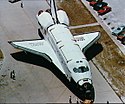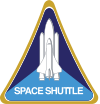STS-41-G
| Missionsemblem | |||||
|---|---|---|---|---|---|
 | |||||
| Missionsstatistik | |||||
| Missionsnavn: | STS-41-G | ||||
| Rumagentur: | NASA | ||||
| Rumfærge: | Challenger (6) | ||||
| Antal besætningsmedlemmer: | 7 | ||||
| Affyringsrampe: | LC-39A (KSC) | ||||
| Opsendelse: | 5. oktober 1984 | ||||
| Landing: | 13. oktober 1984 | ||||
| Landet på: | Kennedy Space Center | ||||
| Varighed: | 8 dage, 5 timer | ||||
| Foto af besætningen | |||||
 | |||||
| Navigation | |||||
| |||||
STS-41-G (Space Transportation System-41-G) var Challengers sjette rumfærge-mission.
Opsendt 5. oktober 1984 og vendte tilbage den 13. oktober 1984.
Besætning

 Robert Crippen (kaptajn)
Robert Crippen (kaptajn)
 Jon McBride (pilot)
Jon McBride (pilot)
 Kathryn Sullivan (missionsspecialist)
Kathryn Sullivan (missionsspecialist)
 Sally Ride (missionsspecialist)
Sally Ride (missionsspecialist)
 David Leestma (missionsspecialist)
David Leestma (missionsspecialist)
 Marc Garneau (Canadian Space Agency)
Marc Garneau (Canadian Space Agency)
 Paul Scully-Power (oceanograf fra US Naval Undersea Warfare Center)
Paul Scully-Power (oceanograf fra US Naval Undersea Warfare Center)
Missionen
Hovedartikler:
Eksterne henvisninger
- STS-41-G NASA (engelsk)
| ||||||||
| ||||||||||||||||||||
Medier brugt på denne side
Flag of Canada introduced in 1965, using Pantone colors. This design replaced the Canadian Red Ensign design.
SVG version of PNG Space Shuttle Logo/Patch.
Forfatter/Opretter: By Rei-artur (diskussion · bidrag)., Licens: CC-BY-SA-3.0
Venus/female symbol.
Challenger's roll-out from the orbiter processing facility (OPF) to the vehicle assembly building (VAB) is underway as preparations continue towards launch of STS-8. Challenger is being towed into the VAB by tractor, with parked cars on all sides. Close-up view of the Challenger as it is towed in to the VAB. The Kennedy Space Center alternative photo number is 108-KSC-83PC-533 (39145).
The crew assigned to the STS-41G mission included (seated left to right) Jon A. McBride, pilot; mission specialists Sally K. Ride, Kathryn D. Sullivan, and David C. Leestma. Standing in the rear, left to right, are payload specialists Paul D. Scully-Power and Marc Garneau with crew commander Robert L. Crippen in the middle. Launched aboard the Space Shuttle Challenger on October 5, 1984 at 7:03:00 am (EDT), the STS-41G mission marked the first flight to include two women. Sullivan was the first woman to walk in space. The crew deployed the Earth Radiation Budget Satellite (ERBS), connected the components of the Orbital Refueling System (ORS) which demonstrated the possibility of refueling satellites in orbit, and carried 3 experiments of the Office of Space Terrestrial Applications-3 (OSTA-3).
View of the SIR-B antenna being deployed during STS 41-G. The Challenger's payload bay is open and the remote manipulator system (RMS) arm is in the stowed position at the right of the view.
View of the ERBS satellite during deployment on STS-41-G.
Forfatter/Opretter: Rei-artur (diskussion · bidrag), reshaped by F l a n k e r (talk), Licens: CC-BY-SA-3.0
symbol of Mars. 400 × 400 pixels nominal dimensions, line 45 pixel tick, circle 295 × 295 pixel, not joined with arrow. Colour: red=0 green=0 blue=140.
![]() Vektorgrafikken blev lavet med Inkscape.
Vektorgrafikken blev lavet med Inkscape.
Astronaut Kathryn Sullivan checks the latch of the SIR-B antenna in the Challenger's open cargo bay during her extravehicular activity (EVA). The orbital refueling system (ORS) is just beyond the mission specialist's helmet. To the left is the large format camera (LFC). The LFC and ORS are stationed on a device called the mission peculiar experiment support structure (MPESS).















